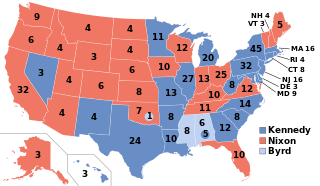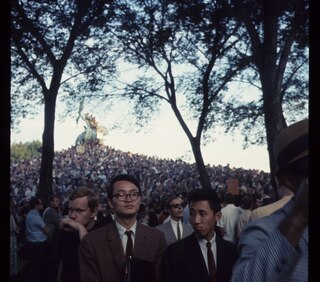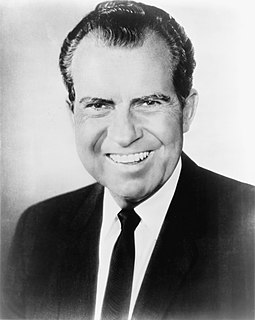
The 1960 United States presidential election was the 44th quadrennial presidential election. It was held on Tuesday, November 8, 1960. In a closely contested election, Democratic United States Senator John F. Kennedy defeated the incumbent Vice President Richard Nixon, the Republican Party nominee. This was the first election in which fifty states participated, and the last in which the District of Columbia did not, marking the first participation of Alaska and Hawaii. This made it the only presidential election where the threshold for victory was 269 electoral votes. It was also the first election in which an incumbent president was ineligible to run for a third term because of the term limits established by the 22nd Amendment. This is the most recent election in which three of the four major party nominees for President and Vice-President were eventually elected President of the United States. Kennedy won the election, but was assassinated and succeeded by Johnson in 1963, who won re-election in 1964. Then, Nixon won the 1968 election to succeed Johnson who decided not to run for re-election that year. Of the four candidates, only Vice Presidential nominee Henry Cabot Lodge, Jr. failed to succeed to the presidency.

The 1968 United States presidential election was the 46th quadrennial presidential election, held on Tuesday, November 5, 1968. The Republican nominee, former vice president Richard Nixon, defeated the Democratic nominee, incumbent vice president Hubert Humphrey, and the American Independent Party nominee, former Alabama governor George Wallace.
The 1968 Democratic National Convention was held August 26–29 at the International Amphitheatre in Chicago, Illinois, United States. Earlier that year incumbent President Lyndon B. Johnson had announced he would not seek reelection, thus making the purpose of the convention to select a new presidential nominee for the Democratic Party. The keynote speaker was Senator Daniel Inouye of Hawaii. Vice President Hubert Humphrey and Senator Edmund Muskie of Maine were nominated for president and vice president, respectively. The most contentious issues of the convention were the continuing American military involvement in the Vietnam War and voting reform, particularly expanding the right to vote for draft-age soldiers who were unable to vote as the voting age was 21. The convention also marked a turning point where previously idle groups such as youth and minorities became more involved in politics and voting.

Hubert Horatio Humphrey Jr. was an American pharmacist and politician who served as the 38th vice president of the United States from 1965 to 1969. He twice served in the United States Senate, representing Minnesota from 1949 to 1964 and 1971 to 1978. As a senator he was a major leader of modern liberalism in the United States. As President Lyndon Johnson's vice president, he supported the controversial Vietnam War. An intensely divided Democratic Party nominated him in the 1968 presidential election, which he lost to Republican nominee Richard Nixon.

Jerry Clyde Rubin was an American social activist, anti-war leader, and counterculture icon during the 1960s and 1970s. During the 1980s, he became a successful businessman. He is known for being one of the co-founders of the Youth International Party (YIP), whose members were referred to as Yippies, and standing trial in the Chicago Seven case.

The Youth International Party (YIP), whose members were commonly called Yippies, was an American youth-oriented radical and countercultural revolutionary offshoot of the free speech and anti-war movements of the late 1960s. It was founded on December 31, 1967. They employed theatrical gestures to mock the social status quo, such as advancing a pig as a candidate for president of the United States in 1968. They have been described as a highly theatrical, anti-authoritarian and anarchist youth movement of "symbolic politics".

The 1968 Republican National Convention was held at the Miami Beach Convention Center in Miami Beach, Dade County, Florida, from August 5 to August 8, 1968, to select the party's nominee in the general election. It nominated former Vice President Richard M. Nixon for president and Maryland Governor Spiro T. Agnew for vice president. It was the fourth time Nixon had been nominated on the Republican ticket as either its vice presidential or presidential candidate (1960).

The 1972 Republican National Convention was held from August 21 to August 23, 1972 at the Miami Beach Convention Center in Miami Beach, Florida. It nominated President Richard M. Nixon and Vice President Spiro T. Agnew for reelection. The convention was chaired by House minority leader and future Nixon successor Gerald Ford of Michigan. It was the fifth time that Nixon had been nominated on the Republican ticket for vice president or president. Nixon's five appearances on his party's ticket matched the major-party American standard of Franklin D. Roosevelt, a Democrat who had been nominated for vice president once and president four times.

Pigasus, also known as Pigasus the Immortal and Pigasus J. Pig, was a 145-pound (66 kg) domestic pig that was nominated for President of the United States as a theatrical gesture by the Youth International Party on August 23, 1968, just before the opening of the Democratic National Convention in Chicago, Illinois. The youth-oriented party was an anti-establishment and countercultural revolutionary group whose views were inspired by the free speech and anti-war movements of the 1960s, mainly the opposition to United States involvement in the Vietnam War.
The Spring Mobilization Committee to End the War in Vietnam, which became the National Mobilization Committee to End the War in Vietnam, was a coalition of American antiwar activists formed in November 1966 to organize large demonstrations in opposition to the Vietnam War. The organization was informally known as "the Mobe".

From January 24 to June 20, 1972, voters of the Democratic Party chose its nominee for president in the 1972 United States presidential election. Senator George McGovern of South Dakota was selected as the nominee through a series of primary elections, caucuses, and state party conventions, culminating in the 1972 Democratic National Convention held from July 10 to July 13, 1972, in Miami, Florida.

Protest activity against the Vietnam War took place prior to and during the 1968 Democratic National Convention.

From March 12 to June 11, 1968, voters of the Republican Party chose its nominee for president in the 1968 United States presidential election. Former vice president Richard Nixon was selected as the nominee through a series of primary elections and caucuses culminating in the 1968 Republican National Convention held from August 5 to August 8, 1968, in Miami Beach, Florida.

The 1968 presidential campaign of Hubert Humphrey began when Vice President of the United States Hubert Humphrey of Minnesota decided to seek the Democratic Party nomination for President of the United States following President Lyndon B. Johnson's announcement ending his own bid for the nomination. Johnson withdrew after an unexpectedly strong challenge from anti-Vietnam War presidential candidate, Senator Eugene McCarthy of Minnesota, in the early Democratic primaries. McCarthy, along with Senator Robert F. Kennedy of New York, became Humphrey's main opponents for the nomination. Their "new politics" contrasted with Humphrey's "old politics" as the increasingly unpopular Vietnam War intensified.

The 1968 presidential campaign of Richard Nixon, the 36th vice president of the United States, began when Nixon, the Republican nominee of 1960, formally announced his candidacy, following a year's preparation and five years' political reorganization after defeats in the 1960 presidential election and the 1962 California gubernatorial election.

The 1968 United States presidential election in North Carolina took place on November 5, 1968, and was part of the 1968 United States presidential election. Voters chose 13 representatives, or electors to the Electoral College, who voted for president and vice president.

The 1968 United States elections were held on November 5, and elected members of the 91st United States Congress. The election took place during the Vietnam War, in the same year as the Tet Offensive, the assassination of Martin Luther King, Jr., the assassination of Robert F. Kennedy, and the protests of 1968. The Republican Party won control of the presidency, and picked up seats in the House and Senate, although the Democratic Party retained control of Congress.

"Superman Comes to the Supermarket" is an essay by the American novelist and journalist Norman Mailer about the 1960 Democratic convention. Originally published in Esquire as "Superman Comes to the Supermart," this essay was Mailer's initial foray into political journalism. It characterizes John F. Kennedy as a potential "existential hero" who could revitalize the US after eight years under Dwight D. Eisenhower to rediscover its lost imagination. "Superman" further develops and emphasizes Mailer's concern with the importance of the individual's will and creativity that must challenge conformity and obedience in American life to fully realize a genuine life. With "Superman", Mailer extends New Journalism by taking an active role in the narrative, which would characterize much of his subsequent journalistic style and lead to his Pulitzer Prize for The Armies of the Night in 1968.

The 1968 United States presidential election in Florida was held on November 5, 1968. Florida voters chose fourteen electors, or representatives to the Electoral College, who voted for president and vice president.
"In the Red Light: A History of the Republican Convention in 1964" is an essay written by Norman Mailer for Esquire about the Republican National Convention in 1964. Like Mailer's other journalism in the 1960s, "Red Light" uses the subjective techniques of new journalism and assumes a third-person persona to participate in, report on, and comment on the events in California in the summer of 1964. The essay is divided into three sections: the events leading up to the convention, including Goldwater's rise, the events leading up to Goldwater's nomination, and Mailer's view of his acceptance.















